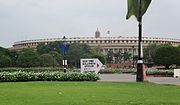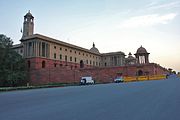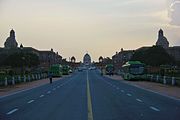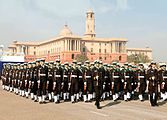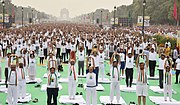Raisina Hill
Raisina Hill
Rāyasīnā kī Pahāṛī | |
|---|---|
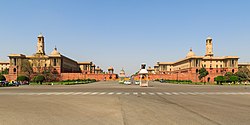 Vijay Chowk with North and South Block of the Secretariat Building in the backdrop. As one looks at the Raisina Hill buildings from Vijay Chowk, the Rashtrapati Bhavan disappears and only its dome is visible. | |
| Coordinates: 28°36′50″N 77°12′18″E / 28.614°N 77.205°E | |
| Country | |
| Union Territory | |
| Districts | New Delhi |
| City | New Delhi |
| Government | |
| • Type | Municipal Council |
| • Body | New Delhi Municipal Council |
| Time zone | UTC+5:30 (IST) |
Raisina Hill (ISO: Rāyasīnā kī Pahāṛī), often used as a metonym for the seat of the Government of India, is an area of New Delhi, housing India's most important government buildings, including Rashtrapati Bhavan, the official residence of the President of India on a citadel and the Secretariat building, housing the Prime Minister's Office and several other important ministries. The hill is seen as an Indian acropolis with Rashtrapati Bhavan as the Parthenon.[1][2]
History of Raisina Hill
[edit]The British architect Edwin Landseer Lutyens, a major member of the city-planning process, was given the primary architectural responsibility. The completed Viceroy's House turned out very similar to the original sketches which Lutyens sent Herbert Baker, from Shimla, on 14 June 1912. Lutyens' design is grandly classical overall, with colours and details inspired by Indian architecture. Lutyens and Baker, who had been assigned to work on Viceroy's House and the Secretariat building, began on friendly terms. Baker had been assigned to work on the two secretariat buildings which were in front of the Viceroy's House. The original plan was to have Viceroy's House on the top of Raisina Hill, with the secretariats lower down. It was later decided to build it 400 yards back and put both buildings on top of the plateau.[3] The contract was awarded to multiple contractors, including primarily Sir Sobha Singh.[4]
Under the Central Vista project, the Prime Minister’s residence will be shifted behind the existing South Block, while the Vice President's residence is proposed to be relocated behind North Block. The Vice President's enclave will be on a site of 15 acres, with 32 five-storey buildings at a maximum height of 15 meters. The Prime Minister's new office and residence will be on a site of 15 acres, with 10 four-storey buildings at a maximum height of 12 meters with a building for keeping the Special Protection Group.[5]
Gallery
[edit]-
Vijay Chowk at Kartavya Path, with Secretariat Building in the background, New Delhi, the venue of the Beating Retreat ceremony
-
North and South Block of the Secretariat Building illuminated
-
Old Parliament House, New Delhi as seen from the Kartavya Path
-
North Block of the Secretariat Building seen from Kartavya Path
-
South Block of the Secretariat Building seen from Kartavya Path
-
Rashtrapati Bhavan seen from Kartavya Path
-
Panoramic view of Kartavya Path
-
Indian Naval contingent marching on the Kartavya Path during Delhi Republic Day parade
-
A band performance at India's Beat Retreat ceremony at Vijay Chowk in 2018.
-
International Day of Yoga on 21 June 2018
Delhi Metro
[edit]The nearest Delhi Metro stations to the Raisina Hill are: Central Secretariat, Lok Kalyan Marg, Udyog Bhawan, Janpath, Rajiv Chowk, Patel Chowk.
See also
[edit]References
[edit]- ^ "The might of Raisina Hill". The Indian Express. 7 May 2012. Archived from the original on 8 January 2014. Retrieved 18 July 2012.
- ^ Goyal, Shikha (8 March 2017). "20 amazing facts about the Rashtrapati Bhavan". jagranjosh.com. Jagran Prakashan Limited. Archived from the original on 10 November 2021. Retrieved 14 July 2022.
- ^ "The history of Rashtrapati Bhavan : The official home of the President of India". 19 September 2015.
- ^ Dayal, Mala (2010). Celebrating Delhi. Penguin Books India. ISBN 978-0-670-08482-1.
- ^ "Central Vista: PM residence to have 10 buildings; sources say no question of dropping proposed PMO | India News - Times of India". The Times of India. PTI. 18 December 2020. Retrieved 31 October 2022.





